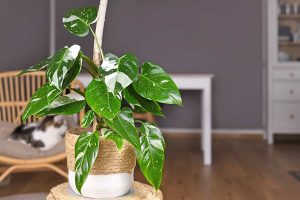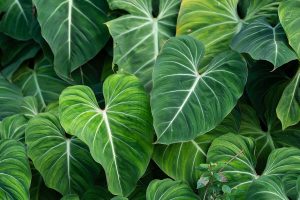The Burle Marx Philodendron is a low-growing tropical shrub hailing from the rainforests of Brazil. It features long arrow-shaped leaves in a bright, fresh green color. The foliage has a glossy texture, with heavy veining, which gives the effect of ribbed leaves. The variegated variety of this plant has splashes of yellow on the foliage in a random pattern, and the veining is more subtle so that the leaves appear to be gently rippled.
This is a popular type of Philodendron, which is commonly grown as a houseplant, though the variegated version is much rarer. It is named after Roberto Burle Marx, who was one of the most influential landscape designers of the 20th century.
Marx is credited with introducing modern, native landscape architecture to Brazil, and he played a pivotal role in supporting the conservation of the Brazilian rainforests. Marx has many plants named after him, including the Burle Marx Philodendron, which he counted among his collection of over 500 Philodendrons he grew at home.
Here we take a closer look at the Variegated Burle Marx Philodendron and offer detailed care advice to ensure your Philodendron thrives.
| Botanical name | Philodendron Burle-Marxii Variegata |
| Common names | Variegated Burle Marx Philodendron |
| Plant family | Araceae |
| USDA hardiness zone | 9- 11 |
| Mature height | 2 feet |
| Mature spread | 4 feet |
Table of Contents
Varieties of Variegated Philodendrons
Pink Princess Philodendron

This variegated variety of Philodendron has showy leaves with splashes of pink set against dark green. It is a very trendy type of Philodendron that has gained a huge following from houseplant lovers on social media.
Philodendron Brasil

This is one of the most common types of variegated Philodendron, with heart-shaped leaves growing along a trailing vine. The emerald green leaves feature portions of lime green and yellow areas to create a distinctive, bright foliage plant.
How to Care for Your Variegated Burle Marx Philodendron
The Variegated Burle Marx Philodendron should be cared for in the same way as most other varieties of Philodendron, with some slight alterations regarding light. It is not a difficult plant to grow as long as you understand the needs of this evergreen plant.
Light

In its native habitat, the Burle Marx Philodendron grows beneath the canopy of taller trees. It is a low-growing shrub that benefits from the dappled shades of the plants growing overhead. When grown as a houseplant, the Burle Marx Philodendron will perform best if its natural lighting conditions are mimicked.
This will entail ensuring the plant receives a good level of bright, indirect light. Avoid subjecting the Burle Marx Philodendron to direct light because this will cause the foliage to scorch, resulting in brown leaves.
Many types of Philodendron will survive in low lighting, but the rate of growth will be slowed. However, the Variegated Burle Marx Philodendron will struggle in low lighting because it has a reduced capacity to photosynthesize. Chlorophyll is only present in the green parts of the leaves, so additional natural light is needed to ensure photosynthesis.
To keep the plant healthy and thriving, set the plant in front of an east or west-facing window, which will allow the plant to receive several hours of bright indirect light each day while also keeping it out of direct light.
If you are growing the Variegated Burle Marx Philodendron outside in a garden, plant it against a fence or hedge where it will benefit from partial shade, or situate it below a sparsely branched tree to create some dappled shade.
Soil
Like other Philodendrons, the Variegated Burle Marx Philodendron should be grown in moist but not wet soil. To achieve this, you will need a good watering regime in conjunction with an appropriate type of soil. Since the Variegated Burle Marx Philodendron will not tolerate sitting in standing water or wet soil, a substrate that is well-draining is essential.
A well-draining soil is able to encourage water to drain through the soil to the bottom of the pot, where it can escape through drainage holes, rather than a poorly draining soil that would hold excess moisture against the roots. The plant also likes to have access to consistent moisture, so the soil that drains too quickly will also not be appropriate because this won’t hold enough water around the roots.
Instead, opt for well-draining soil made up of perlite and sand, along with peat and organic compost. This will create a good balance that will not drain too quickly or too slowly. You could also use pre-mixed soil intended for tropical plants.
Water

A Variegated Burle Marx Philodendron should be watered much like other varieties of Philodendron. They should not be watered so heavily that the soil becomes waterlogged, but they should also not be allowed to dry out entirely between waterings. What you want to do is achieve a good balance, whereby the plant receives additional water before the previous water used dries out.
You can do this by regularly monitoring the condition of the soil. This involves dipping a finger into the soil and testing for moisture. Once the top two inches of the soil feel dry to the touch, you can go ahead and water the Variegated Burle Marx Philodendron.
However, if you can feel moisture within the top two inches of soil, then you should wait an additional few days before retesting the soil and watering it again. You can expect to water the plant around two to three times a month during spring and summer and around once a month in fall and winter, but it is always best to check the condition of the soil before adding water.
This is because overwatering is one of the main causes of death among Philodendrons since they are not able to survive in overly wet soil. Overwatering causes root rot, which deprives the plant of nutrients and moisture, leading to the demise of the plant.
Temperature
The Variegated Burle Marx Philodendron is native to the rainforests of Brazil, where temperatures remain warm all year round. When growing this plant outside of its natural habitat, the climate conditions should be as similar as possible to its native home. The ideal temperature range for a Burle Marx Philodendron is between 65 and 80°F.
It works well as a houseplant because the average room temperature in a home or office is between 68 and 72°F. It can tolerate temperatures below 65°F for short periods of time, but if the temperature dips below 55°F, the plant will not survive. If you live in USDA hardiness zones 9, 10, or 11, then you can grow this plant outside through every season.
Humidity
Humidity is essential for most Philodendrons, and the Variegated Burle Marx Philodendron is no exception. These plants are accustomed to high levels of humidity in the Brazilian rainforest, and you should aim to replicate these conditions for your houseplant.
The best spot for the Burle Marx Philodendron would be in a bathroom or kitchen because these rooms have higher levels of humidity due to the use of showerheads and faucets. If you are keeping the plant in a room with low or average humidity levels, you can increase the humidity in various ways to help the plant thrive.
An easy and inexpensive solution is to mist the leaves of the Variegated Burle Marx Philodendron every other day with a water spray, though this method is reliant on you having the time to mist the plants and the ability to remember to do so. You could alternatively buy an electric humidifier to increase the humidity across an entire room or group the Philodendron amongst other tropical plants.
Fertilizer

The Burle Marx Philodendron will grow well without fertilizer, but if you wish to apply feed to your plant, use a fertilizer specially formulated for Philodendrons, or use an all-purpose liquid fertilizer diluted to 50% with water.
Variegated Burle Marx Philodendron FAQs
Can you propagate a Variegated Burle Marx Philodendron?
This plant is a joy to propagate because it has a high success rate. Propagation is achieved most easily with stem cuttings. This will require you to remove a section of the stem, which includes a node, and then place the node into moist soil or into a jar of water. After a few weeks, roots will appear, and the cutting can be transplanted to a larger pot.
Are Variegated Burle Marx Philodendrons easy to grow?
These plants are quite low maintenance and easy to grow as long as you provide them with the appropriate care. Plenty of bright indirect light is one of the most important requirements for a Variegated Burle Marx Philodendron, along with a watering regime that does not overwater or underwater the soil.
Are Variegated Burle Marx Philodendrons toxic?
The Variegated Burle Marx Philodendron is toxic to both humans and household pets. It contains calcium oxalate crystals which cause inflammation and irritation when ingested. If you suspect a child or pet has nibbled on the plant, seek professional medical advice.






